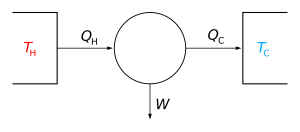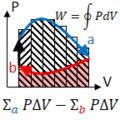Thermodynamic cycle facts for kids
A thermodynamic cycle is like a journey that a system takes, always ending up right where it started. Imagine a machine that goes through different steps, but after all the steps, it's ready to begin again. In these cycles, things like temperature and pressure return to their original state.
Even though the system returns to its start, important things like heat and work can change during the journey. The first law of thermodynamics tells us that any heat added to the system must equal the work it does. This repeating nature is why these cycles are so important for engines and power plants.
If the cycle moves in a clockwise direction on a special chart (called a P-V diagram), it usually means it's a heat engine. This kind of engine produces useful work. If it moves counter-clockwise, it's often a heat pump, which uses work to move heat around.
Contents
What are the Main Types of Cycles?
There are two main types of thermodynamic cycles: power cycles and heat pump cycles. Think of them as doing opposite jobs.
Power Cycles: Making Things Move
Power cycles are all about turning heat into useful mechanical work. These cycles are the secret behind most of the world's electric power plants. They also make almost all motor vehicles move!
These cycles are used to understand how different engines work. For example:
- The Otto cycle helps us understand how gasoline engines in cars operate.
- The Diesel cycle explains how diesel engines work, often found in trucks and buses.
Other power cycles model engines that burn fuel outside, like:
- The Brayton cycle is used for gas turbines, which power jet planes and some power plants.
- The Rankine cycle explains steam turbines, which are common in large power stations that use steam to generate electricity.
Images for kids
See also
 In Spanish: Ciclo termodinámico para niños
In Spanish: Ciclo termodinámico para niños




